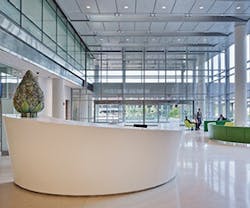Hospitals are by their very nature complex buildings, the designs of which must carefully balance the needs of patients, staff and other stakeholders, all while meeting stringent operational requirements. Existing hospitals face an even greater challenge when it comes to renovations and additions, as medical services must continue without interruption.
So when global multidisciplinary firm Perkins+Will, along with a team of design and engineering consultants, leading artists, and The Johns Hopkins Hospital facilities staff got together to design a new 1.6-million-square-foot complex for the nation’s top-ranked hospital and medical research center, it is no exaggeration to say it was an undertaking of epic proportions.
The Johns Hopkins Hospital in Baltimore includes two 12-story towers for children’s and adult healthcare that rise from an 8-story structural base that composes a unified clinical building, distinguished by its curved shape, articulated forms, bold color, gardens and natural light.
“Overall, the client’s goals were to create a project that maximized functional, programmatic space…but at the same time be a way to create a new image for the hospital, a new front door, and to create two identities,” explains Jean Mah, FAIA, FACHA, LEED AP, planning principal at Perkins+Will. According to Mah, the building was designed to be as flexible and adaptable to the future as possible, while also unifying The Charlotte R. Bloomberg Children’s Center and the Sheikh Zayed Tower under a single theme.
The complex includes 560 private patient rooms, 33 state-of-the-art operating rooms, and expansive new adult and pediatric emergency departments. Its integrated planning and design supports both the most advanced medical technologies and the latest evidence-based design (EBD) strategies for true patient-oriented care.
While EBD features such as single-patient rooms, views to the outdoors, daylighting and strategically-located hand washing stations were used throughout the project, the design team heavily emphasized lighting and acoustics. “From a reduction of medical errors and improved accuracy, patient safety and staff safety [standpoint], we have very carefully designed the lighting levels—the lighting on surfaces and the patient caregiving sites—in order to improve visibility and accuracy,” says Mah.
Increasingly, quality patient care also includes acoustical sensitivity. PageBreak
According to Carolyn BaRoss, IIDA, ASID, LEED AP, design principal at Perkins+Will, the client was “very aware of the problem of noise in the healthcare environment and its impact on patients’ ability to rest and heal, on stress levels, as well as on the staff’s ability to hear communication clearly and to be able to focus on their work. So, there were a lot of strategies within the interior environment that we used to help mitigate sound transmission [to] create as quiet an environment as possible.”
For example, the hospital has a quiet nurse call system to replace the disturbance of constant overhead paging. Other approaches to addressing acoustics include sound-absorptive and deflecting ceiling tiles, soffits and wall configurations; fabric-wrapped wall panels; and even custom lighting fixtures, which serve as both acoustical buffers and dimmable lights for a soft glow at night.
The curvilinear colored metal, glass and brick curtain wall designed in collaboration with artist Spencer Finch serves as the new front door to the hospital, and, by extension, the entire 14-acre campus. A landscaped entry plaza, the size of a football field, leads the way into a two-story sky-lit adult tower lobby with a meditation garden, as well as the soaring four-story children’s lobby.
This welcoming environment extends into the interiors and helps reduce the stress levels of patients and visitors as they arrive. A thoughtful wayfinding plan helps to ease anxious guests as they navigate from public spaces to the various departments within the two towers.
“To have a successful wayfinding solution for these projects, it’s important that all of the elements are working together,” says BaRoss. “It’s not just about effective signage, but that the architectural language, the context, people’s orientation, the quality of the interior, the signage and the organization of the space all work in concert to make it very intuitive and easy to navigate.”
The design team made the decision to introduce windows and transparency throughout the interiors so that visitors can always see daylight and landmarks around the campus to give them a sense of orientation. Color adds another layer of wayfinding assistance and reinforces the identity of the two different towers, not only in public spaces but for staff and back-of-house workers.
Color and light are also instrumental in creating an uplifting experience for patients and staff, which is atypical of healthcare environments, where many clients shy away from bold colors, notes BaRoss. “We really took paint colors directly out of the artist’s tube of paint and looked at the pure, full spectrum of color and felt that that was the most satisfying, timeless and joyful kind of color that we could use,” she says. “To Hopkins’ credit, they are not afraid of color—that’s a quote from the client. They love color, and they’re not afraid of using all colors in the healthcare environment where many other clients sort of have trepidation.” PageBreak
The most striking use of color can be seen in the commissioned artwork spread throughout the hospital. A multidisciplinary collaborative effort including Perkins+Will, art curator Nancy Rosen, Bloomberg Philanthropies, and Johns Hopkins staff and leadership resulted in the selection of more than 500 works of art by more than 70 artists across the country. When added to the facility’s numerous healing gardens and meditative spaces, the result is a dignified, uplifting and nurturing environment.
Given the scope and complexity of the project, what is most notable apart from the cohesiveness of the architecture and design is the level of cooperation achieved by all of the stakeholders in the process.
“I think that what was incredibly unusual and amazing about this team is that there was a level of collaboration with the owner, donor representatives, curator, artists, lighting design, signage, landscape, architecture and interiors that I have rarely ever experienced in my almost 30-year career,” Mah says. “It’s really a story about collaboration. If I could impart that, I think for other projects, there’s so much value in being able to have these open discussions and debates with each other to really get our projects to a better place.”
| SOURCES | |||
|
ceilings flooring Nora Flooring glass (interior) |
seating Coalesse Fredericia Furniture Vitra |
Vladimir Kagan Couture tables textiles Crypton Edelman Leather |
Maharam Nano-Tex tile + stone Nurazzo Tile Valders Stone & Marble |
| CONTACT INFORMATION | |||
|
client |
project team Perkins+Will 617 West 7th Street Suite 1200 Los Angeles, CA 90017 (213) 270-8400 www.perkinswill.com |
||
| principal leadership | |||
| Eric Van Aukee, AIA, managing principal Ralph Johnson, FAIA, design principal Jean Mah, FAIA, planning principal Jerry Johnson, AIA, design principal |
Carolyn BaRoss, ASID, IIDA,
interior design principal Bruce Toman, AIA, technical principal William Schmalz, AIA, technical principal Dan Moore, AIA, principal Jocelyn Frederick, planning principal |
||
| PROJECT TEAM | |||
| Todd Accardi, medical planner Hussein Alayyan, technical coordinator Stephanie Augustyn, medical planner Annelise Chikhale, medical planner Heayoung Cho, interior designer Brian Churchill, technical coordinator Regina Clark, construction administration Alan Ernst, AIA, senior project architect Jamie Feuerborn, IIDA, interior designer Peter Frisbee, AIA, senior project architect Shannon Gedey, AIA, architect April Goshe, AIA, architect Jason Harper, AIA, project manager Carrie Hincapie, technical coordinator Ji Hye Lee, interior designer Stephen Leighton, AIA, senior project architect Ken Lowery, AIA, project architect David McAfee, senior project architect |
Larry Metcalf, senior medical planner Laura Morris, senior interior designer Francis Murphy, interior designer Mariyana Pampova, interior designer Avivah Rapoport, AIA, project manager Charles Sejud, AIA, project manager Billy Simcox, construction administration G. Steven South, IIDA, interior project designer Andrea Stalker, technical coordinator Wally Szczerba, architect Lynnette Tedder, IIDA, senior interior designer Jose Vaquero, job captain Jake West, construction administrator Norma Williams, construction administration Ed Witkowski, AIA, senior project designer |
||
| PHOTOGRAPHER Eduard Hueber |
|||
# # #
For a complete source list of products and furnishings specified for this project, click here.
About the Author
Robert Nieminen
Chief Content Director
Chief Content Director, Architectural Products, BUILDINGS, and interiors+sources
Robert Nieminen is the Chief Content Director of three leading B2B publications serving the commercial architecture and design industries: Architectural Products, BUILDINGS, and interiors+sources. With a career rooted in editorial excellence and a passion for storytelling, Robert oversees a diverse content portfolio that spans award-winning feature articles, strategic podcast programming, and digital media initiatives aimed at empowering design professionals, facility managers, and commercial building stakeholders.
He is the host of the I Hear Design podcast and curates the Smart Buildings Technology Report, bringing thought leadership to the forefront of innovation in built environments. Robert leads editorial and creative direction for multiple industry award programs—including the Elev8 Design Awards and Product Innovation Awards—and is a recognized voice in sustainability, smart technology integration, and forward-thinking design.
Known for his sharp editorial vision and data-informed strategies, Robert focuses on audience growth, engagement, and content monetization, leveraging AI tools and SEO-driven insights to future-proof B2B publishing.

